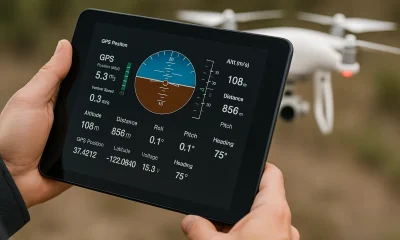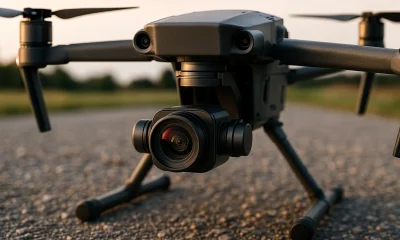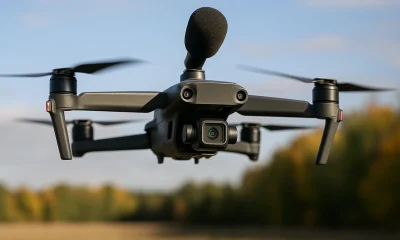Public safety
Vertiports – What do They do?

Vertiports: The Future of Urban Air Mobility
As cities around the world continue to grow and traffic congestion becomes an ever-increasing problem, innovative solutions are being developed to revolutionize urban transportation. Among these, vertiports are emerging as a key infrastructure component for the future of urban air mobility. This article explores what vertiports are, their features, and how they will be utilized to transform urban travel.
What are Vertiports?
Vertiports are specialized facilities designed to support vertical take-off and landing (VTOL) aircraft, including electric vertical take-off and landing (eVTOL) vehicles. These facilities are similar to traditional airports but are specifically tailored to the unique needs of VTOL aircraft. They provide the necessary infrastructure for the safe, efficient, and effective operation of these new forms of air transportation.
Key Features of Vertiports
- Landing and Take-off Areas
- Vertiports feature designated spaces for VTOL aircraft to land and take off vertically. These areas are equipped with advanced guidance and navigation systems, including ground-based radar and satellite-based GPS, to ensure safe operations even in densely populated urban areas.
- Charging and Maintenance Stations
- As many VTOL aircraft are electric, vertiports include facilities for recharging batteries. Fast-charging stations ensure quick turnaround times for aircraft, while maintenance stations provide spaces for routine checks and repairs to keep the vehicles in optimal condition.
- Passenger Terminals
- Vertiports are equipped with passenger terminals that include amenities such as waiting lounges, ticketing counters, security checkpoints, and boarding areas. These terminals are designed to offer a seamless and comfortable experience for passengers.
- Air Traffic Control
- To manage the movement of VTOL aircraft, vertiports are equipped with air traffic control systems. These systems coordinate the take-off and landing sequences and manage air traffic within the vicinity of the vertiport to ensure safety and efficiency.
- Integration with Other Transport Modes
- Vertiports are often strategically located to integrate with other forms of transportation, such as buses, trains, and traditional airports. This connectivity ensures that passengers can easily transition between different modes of travel, making their journey as seamless as possible.
Utilization of Vertiports
Vertiports are set to play a pivotal role in the future of urban transportation. Here are some key areas where vertiports will be utilized:
- Urban Air Mobility
- Vertiports will facilitate the use of VTOL aircraft for short-distance urban travel, significantly reducing commute times. For instance, a trip that might take an hour by car could be reduced to just a few minutes by VTOL aircraft.
- Emergency Services
- In emergency situations, vertiports can be used to quickly deploy medical personnel, transport patients, or deliver critical supplies. The ability to bypass traffic congestion can be lifesaving in time-sensitive scenarios.
- Logistics and Cargo Transport
- Vertiports can also support the transportation of goods. Companies can use VTOL aircraft to deliver packages and supplies more quickly and efficiently, especially in urban areas where road traffic can cause delays.
- Tourism and Sightseeing
- Vertiports can provide unique tourism and sightseeing opportunities, allowing visitors to experience cities from a new perspective. VTOL aircraft can offer scenic tours, providing breathtaking views of urban landscapes.
- Business Travel
- For business travelers, vertiports can offer a faster and more efficient means of transportation within cities, allowing them to attend meetings and events with reduced travel time.
Challenges and Considerations
While vertiports offer numerous benefits, their implementation also presents several challenges:
- Regulatory and Safety Standards
- Developing regulatory frameworks and safety standards for VTOL aircraft and vertiports is crucial. Authorities must ensure that these new modes of transportation meet stringent safety requirements to protect passengers and the public.
- Infrastructure Development
- Building vertiports requires significant investment and urban planning. Cities must carefully consider the locations and integration of vertiports to maximize their efficiency and minimize disruption to existing infrastructure.
- Noise and Environmental Impact
- The operation of VTOL aircraft can generate noise, which may affect residents in urban areas. Additionally, the environmental impact of increased air traffic must be assessed and mitigated through the use of electric and sustainable technologies.
- Public Acceptance
- Gaining public acceptance for new transportation technologies is essential. Cities and companies must engage with communities to address concerns and highlight the benefits of vertiports and VTOL aircraft.
Conclusion
Vertiports represent a significant advancement in urban transportation, offering a solution to the growing challenges of traffic congestion and mobility. By providing the necessary infrastructure for VTOL aircraft, vertiports have the potential to transform how we travel within cities, making transportation faster, more efficient, and more sustainable. As technology continues to evolve, the development and utilization of vertiports will play a crucial role in shaping the future of urban air mobility.
For more information on Drone Acronyms use in this article visit our page.











